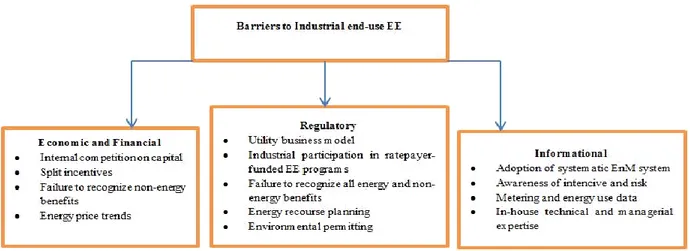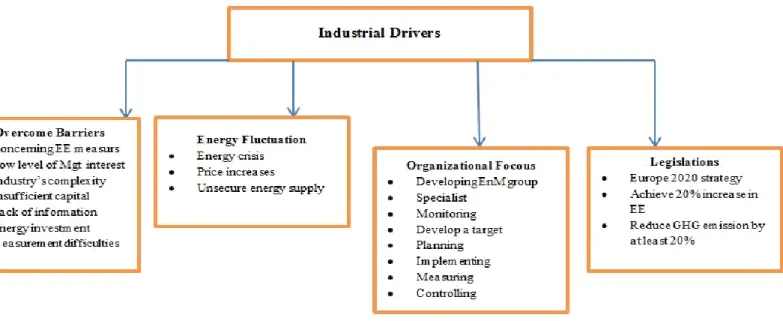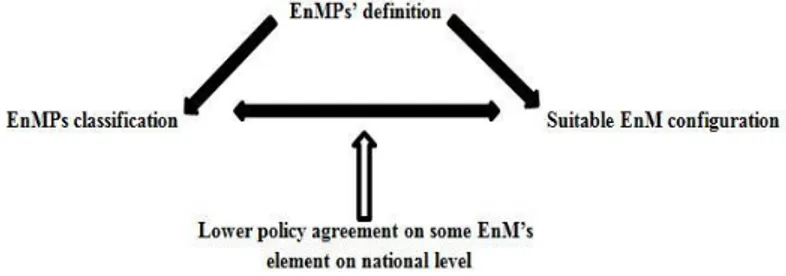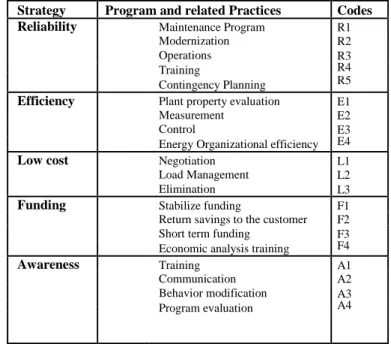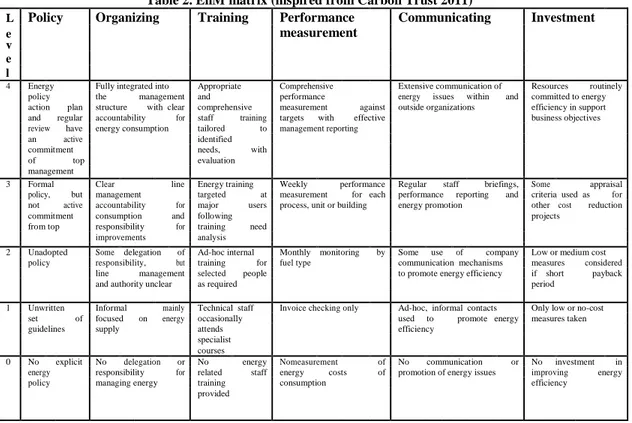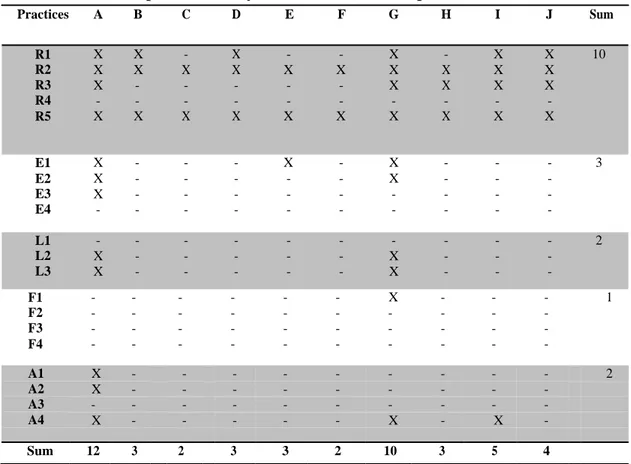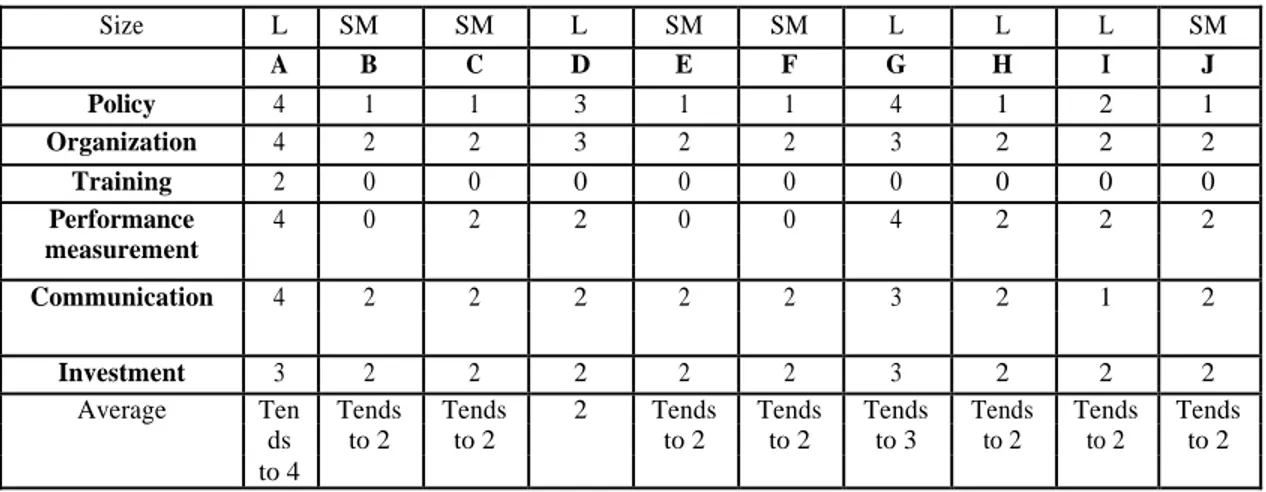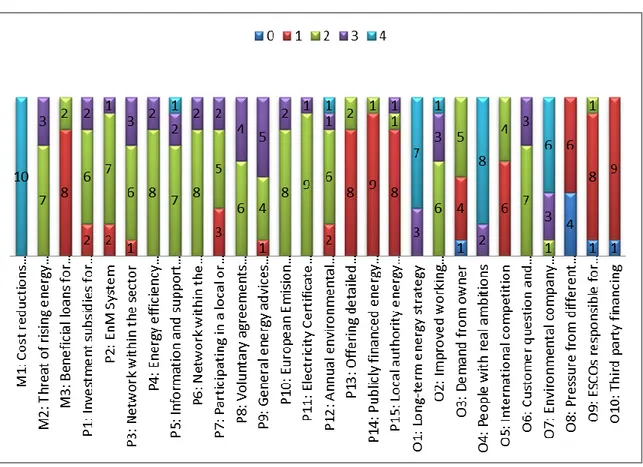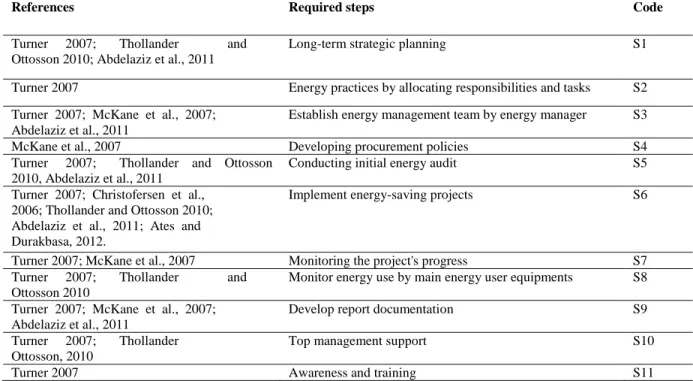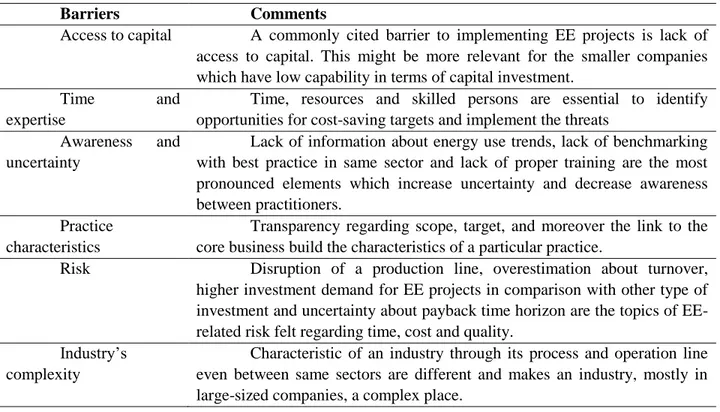Politecnico di Milano
Department of Management, Economics and Industrial Engineering
XXVII cycle of the PhD program in Management, Economics and Industrial Engineering
PhD thesis of AIDA SALIMNEZHADGHAREHZIAEDDINI
Industrial Energy Management
Doctoral program coordinator: Prof. Mariano Corso
Tutor: Prof. Paolo Trucco
University Politecnico di Milano
Economics, Management, and Industrial engineering department
Assessing and Fostering Industrial Energy Management through Energy Management Practic’s Definition and Classification
Tutor: Prof. Paolo Trucco
Supervisor: Prof. Enrico Cagno
PhD thesis of:
Aida Salimnezhadgharehziaeddini
Acknowledgement
It was a long journey. It is true that “life is about what we make to happen”. Lots of things happened and changed in the time while I’v been involved with my PhD. Barring losing confidence so many times I’v lost count, getting stuck just as many times, moving from one place to the other, laptop crashing, needing to concentrate as much as possible, and pure frustration in general, but knowing and believing that I just had to do it in my own time and my own terms was the promising and motivating point.
At any rate, I have finished, but not alone. I could not have succeeded without the invaluable support of a several. Without these supporters, especially the selection of few I’m about to mention, I may not have gotten to where I am today. For this select group, I’d like to give my special thanks, beginning with Prof. Enrico Cagno, my supervisor. Your advices on both research and as well as on my career have been priceless. Thank you for being there always for me. Thank you dear Prof. Cagno.
I’d also like to give a heartfelt, special thanks to Prof. Patrik Thollander, my co-supervisor. You were being a tremendous mentor for me. I would never forget your special character all my life. Your genuine caring and concern and faith in me during the dissertation process enabled me to attend to life while also earning my PhD. Thanks for being so good. It was and it is a great honor for me to work with you. Thank YOU dear Patrik.
Thirdly, I would like to express my special appreciation to Prof. Paolo Trucco, my tutor, whom was and is always together with promising words, construction comments and professional manner. I Would also like to thank my dear discussant, Prof. Marco Taisch, for his constructive questions during the last 3 defense, I had so far.
Therewith, I would also like to thank all my colleagues and friends, both in LIU and Polimi for being this much amazing and for all those happy moments that we shared together. Without you this journey definitely would not be joyful.
Another special thanks from deep in my heart goes to two important persons in my life, two friends, Reyhaneh Fallah and Fahimeh Shabani. Thank you for all your staunch support and believing in me even from very long distance. Thank you for being my friend and supporter.
And the last word, but definitely not the least, all my love, grateful and sincere thanks go to my wonderful family. Baba and Mama, you both are a lovely angel in my life. I might can’t express how deeply I love you. My hands are totally empty in front of all you gave me so far. Thank you for being my parents. Thank you for all your supports. Thank you for being this much great. Love you and THANK YOU.
Politecnico di Milano Aida Sa December 2015
Assessing and Fostering Industrial Energy Management through Energy Management Practic’s Definition and Classification
The work reported here is the PhD thesis of Aida Salimnezhadgharehziaeddini. The work
consists of a collection of five papers focused on energy management (EnM) programs and
practices and also determinant factors in which supporting the decision making process which
lead to the implementation of EnM programs in Small, Medium and Large sized
energy-intensive companies from different sectors. This introductory section has two objectives:
- It clarifies the theoretical and empirical background of the research project, and it presents the
main problem addressed. These topics are discussed in the first part of this introductory section:
“Background”.
- It clarifies the overall objective of the research and it summarizes the aims, methods and
findings of the five included papers, explaining the way in which the papers are aligned with
respect to the overall objective of the research. These topics are discussed in the second part of
this introductory section: “The research project”.
This introductory section is followed by the five papers, which are the main results of the current
thesis.
1.
Part 1: Background
1.1. The importance of Energy Efficiency and Energy Management in industry
Potentials for energy efficiency (EE) activities, energy management (EnM) are huge due
to the numerous inefficient energy-intensive and non-intensive industrial companies. A general
estimation of the investment opportunity by International Finance Corporation (2011) exceeds
100 billion US dollars. Due to the strategic importance of EE, national policies are also
favouring EnM programs within industrial companies (IFC 2011).
Despite the huge potential and favouring policies, the phenomenon that economically
profitable EE investments are not being realized is called “energy-efficiency paradox” (Zhang
2003). It is also known as “energy efficiency gap” expressing the difference between the
potential cost-effective EE investments and the actual investment level implemented (Brown,
2001; Levine et al., 1995; Golove and Eto, 1996; Jaffe and Stavins, 1994; Sanstad and Howarth,
1994. Goldman et al., 2005). Why is that always the case?. The existence of “energy efficiency
paradox” or “energy efficiency gap” is exposed to discussion in terms of market failures and
market barriers (Jaffe and Stavins, 1994; Goldman et al., 2005; Rohdin et al., 2007).
There is considerable potential for improving industrial EE both from technical and
managerial point of view. Nevertheless, it has been addressed the numerous ‘barriers’ inhibit the
adoption of such improvements, such as lack of information, shortage of trained and expertise
personnel and limited access to capital. In particular, the adoption of such improvement
programs may be associated with various ‘hidden costs’ that are difficult to capture within
existing energy-economic models. But while there is a general debate on energy efficiency ‘gap’,
both the policy options and continuous improvement within an organization to overcome this gap
need to be identified and acted upon. Moreover, considerable debate over the most effective
approach is highlighted. The most frequently announced barriers to end-use EE has been shown
in figure1.
Figure 1. Barriers to industrial end-use EE
Nowadays, companies have to consider the efficient and smart use of energy and
resources in manufacturing besides traditional performances to sustain their competitiveness in
their respective industry. Thus, it became a must for manufacturing firms to put more efforts on
in-depth analysis of energy and resource performance through their manufacturing processes and
facilities. A comprehensive process design and plant optimization with a specific focus on EE is
of paramount importance for this purpose. Currently, Potentials to improve EE are far from being
exploited as mentioned by many scholars.
The concept of a barrier to EE is both confused and contested. Although the term is
widely used, there is little consensus on how barriers should be understood, how important they
are in different contexts, and how (if at all) they should be addressed.
Since industrial energy use accounts for roughly one third of global energy demand and
that share is growing steadily, managing energy consumption is vital for manufacturers.
However, nowadays companies have become more aware about the potentials of waste of energy
and associated cost savings. Systematic energy management (EnM) is identified by practitioners
and academics as one of the most effective approach to improve and sustain EE in industries.
The reason can be explained through EnM systematic and program to equip companies with
practices and procedures to continuously realize and capture the possible improvements and new
opportunities. The most announced drivers to implement EnM within an organization can be
categorized as follows in figure 2.
Figure 2. Industrial driver to adopt EnM
Although, there is a lot of evidences in the academic literature which approve the huge
potential of EnM to improve the EE level of the company, still there is no cohesive definition
about EnM and also, there is a huge gap about how exactly EnM could make the improvements
within the companies. Moreover, studies concerning energy services in the industry have not
been extensively exploited. There is no study on classification of energy management practices
(EnMPs). Notably, energy policy measures for improved EE in industry is in need of
clarifications in these regards, as policies involving EnM components forms the backbone of
successful industrial energy policies, e.g. Voluntary Agreements (Rezessy and Bertoldi 2011;
Price 2005; Cagno et al., 2015a). EnMPs are to be seen as more managerial actions, while others
defined it as more technical and operational practices. The lack of single accepted definition for
EnMPs causes imprecise understanding about EnMPs. As another result, no characterization
which could characterize EnMPs’ based on their target exists in the body of EnM literature.
Theses gaps also cause failure in choosing proper EnM configuration through single industry’s
characteristics. In other word, the lack of a precise definition about EnMPs causes both technical
and managerial failure towards improving companies’ EE. If major improvements in EE are the
target for a single industry, many different policy instruments and pre-steps can and must be
taken. As for effective EnM it is pillar to work continuously, for better result it is necessary to
establish policies which could support EnM programs properly and continuously. Even though
an
EnM
system
as
such
cannot
be
seen
as
national
policy,
EnM
standards often comprise the backbone of Voluntary Agreements. According to Jelic´ et al.
(2010) the comparison of national EnM standards illustrates that there is a lower agreement on
some elements. Management commitment, strategic planning, purchasing and design are all
those listed with low agreement level. Policy makers, engineers and scholars are in a position to
think about not only what to install to improve EnM programs, but also how to implement these
measures. Thus to converge an unanimously accepted strategy, close contact between
practitioners, policy makers and scholars is the mainstay. Simultaneously, it causes not only to
avoid any possible confusion in existing program when policy makers and scholars get in touch
with the realness of the industry through the practitioners, but also to establish policies which
support EnM program properly. Thus, regardless of any discipline which laws are relevant to,
they constantly need to be revised by policy makers to innovate and inject new, necessary, and
value added items to the existing program. In Figure 3 a presentation on how these four elements
affect each other’s failure and/or success is shown. Different definitions of a single concept not
only cause inaccurate understanding about it, but also cause improper proceedings to obtain the
desired results. The perspectives of management only or merely technical to the EnM concept
has caused both mentioned problems in industries. However, EnMPs could be defined as total
continuous or frequent managerial and technical actions in a company which aim primarily to
reduce energy costs or secure energy supply and secondary to reduce pollution (Sa et al., 2015a)
.Some authors believe that there is overlap between EnMPs and EE measures. But apart from the
existence of some overlaps it is possible to differentiate EnMPs from EE measure (Trianni et al.,
2013). It is useful to list all EnMPs and group them based on where and how they improve the
EE. Characterization of EnMP through the EnM definition can be a light to better understanding
of what EnM is. Based on EnM literature, there are indications that EnMPs positively link to a
top management support and ambitious, productivity, and firm’s climate friendly R&D (Cagno et
Figure3: EnMPs Gap Analysis (Sa et al., 2015b)
Therefore, according to the mentioned problems, this research intends to contribute to the
companies and academia a better understanding on how to successfully integrate EnM into the
manufacturing process.
2.
Research Project
2.1
Background
Paradox or energy efficiency gap was first defined by Hirst and Brown (1990) meaning
that profitable investments into improved EE is not realized in companies because of the barriers
to EE (Decanio 1993 and 1998; Eichhammer, 2004; Cagno and Trianni 2013; Trianni et al.,
2013; Brunke et al., 2014). A number of papers examined barriers to EE in the industry, some of
the high-ranked for whole sizes being technical risks, lack of options to improve energy
management practices (EnMPs) (Brunke et al., 2014) limited access to capital, lack of time or
low priority given to EE by the top management, poor information quality and/or lack of
information (Brunke et al., 2014) or high transaction costs (DeCanio and Watkins, 1998).
Several studies have identified a low status of Energy Management (EnM) in industrial
companies to be a barrier to EE (Rohdin et al., 2007; Thollander and Ottosson 2010).
Implementing EnM can be a way to improve EE and to reduce the related CO2 emissions
(Christoffersen et al., 2003; Kannan and Boie 2003) and overcome barriers to EE.
To improve EE in the industry through EnM programs, long term energy strategies,
committed and skilled energy managers are both important factors in spurring improved EE in
industrial firms. As several factors promote the efficient use of energy, barriers also exist.
Energy management (EnM) addressed in several scientific papers as a robust and efficient means
to overcome such barriers. The term EnM has been used differently in the academic literature,
and still there is no adhesive definition (Schulze et al., 2015). What many definitions of EnM
have in common is that they primarily concentrate on implementation of energy efficient
technologies and replacing inefficient equipment. However, EnM also includes practices such as
care, operation and maintenance of technology, to maintain an effective functioning. Continuous
work and improvement practices are the first requirements for that (Gordic et al., 2010). The
most recent theoretical and empirical researches about drivers and barriers respectively can be
found in Cagno et al., 2013; Brunke et al., 2014 and Trianni and Cagno 2015. As regards the
foundry sector the most recent comprehensive research about barriers can be found in Trianni et
al., (2013) and for drivers look at Thollander et al., (2013). Meanwhile, previous policy
researchers identified and classified a number of barriers to and drivers for EE in industries
(DeCanio, 1993; de Groot, 2001; Sandberg and Soderstrom, 2003; Thollander and Ottosson
2008). Two of these barriers, namely organizational and behavioral barriers relate to the energy
management practices (EnMPs) within the company. Because in general, the details of how an
EnM program could make continuous improvement within the company have remained largely
unexplored (Christoffersen et al., 2006; Kannan and Boie, 2003; Thollander et al., 2010).
Organizational barriers relate to the unclear division of tasks and the lack of financial resources,
time and skilled personnel (Sardianou, 2008). Personnel values and mindset is included in
behavioral barriers (Lindgren Soroye and Nilsson, 2010; Stern, 1992).
The EE improvements through EnMPs in companies is addressed as an important but
also challenging issue by policy researchers. A compounding of different policy measures has
been introduced to influence industry, both directly and indirectly, including a mixture of
voluntary and non-voluntary standards. This challenge, also, is due to a lack of clear
understanding about EnMPs and also how these should be placed by organizations in order to
improve EE. Guidelines and different standards on EnM emphasize the importance of
monitoring, evaluating and enhancing energy performance at process and system levels.
However, for better results managers need to assess their program to track the strength and
weakness of the current energy plan. The reasons for this relate to the need of verifying and
evaluating companies’ energy strategy and the current situation of the adopted practices together
with assessing companies’ policy, organizing, training, performance measurement,
communication and investment maturity level.
Moreover, implementing EnM is also difficult because of many misconceptions (e.g.
Only big companies can do it, only plants with new equipment can do it, large capital budgets
are required, we have no enough time and staff, we already do everything we can, and everybody
manages energy) and the barriers which depends on the geographic location and industry’s
character itself (such as energy intensity and size). Therefore, EnM programs with its huge
potential for improved EE is still far from what it should be exploited in practice based on the
adopted highest success levels (Sa et al., 2015). Those potentials have been untapped not only
because of the mentioned barriers, but also because of lack of alignment between energy
programs and company’s total strategy or company’s macroeconomic policy and also because of
lack of transparency which accordingly increases the nature of risk. Within the last twenty years,
by increasing energy prices and global energy crisis, EnM considerably developed as an
industrial energy system support function. The former studies addressed its strategic and efficient
role in improved energy system. Meanwhile, the number of empirical and theoretical studies
increased about drivers for and barrier to the EE project implementation. However, EnM is not
properly decided upon and/or not fully adopted, with all its potential, to help companies for
improving their EE performance level. In macro perspective, there are two different perspectives
in EE literature about investment decision making“. A number of former researchers believe EE
investments would decide upon if the financial analysis conforms the investment for a particular
program (which is in line with finance theory). However, others emphasis on organizational
energy culture, power relationship, managers mindset and characteristics of the investment itself.
Strategic decision making literature did not provide a clear and applicable answer about what
makes an investment strategic. However, some researchers in this field are described strategic
decisions as follow:
Table1. Strategic investment descriptions
References Description of strategic investment
Butler et al., 1991; Lu and Heard 1995; Decisions as vital importance. Schoemaker 1993
Carr and Tomkins 1996 Decisions which have a significant effect on the organization as a whole. Butler et al., 1991; Carr and Tomkins 1996; Decisions which have a significant potential for improving corporate Cauwenbergh et al., 1996 performance.
Cossette 2004 Strategic means important and not secondary issue.
Child 1972 Decisions which regarding the goals, domains, technologies and structure of a firm.
Dereumaux and Romelaer 2001 Decisions regarding a firm’s development through products-market- technologies triplets
The definition provided by strategic process research are not comprehensive enough to
understand the strategic character of investment decisions because the aspect of the scope and
content of investments did not take into the account properly. Adopting a practice based on how
it is aligned with an organization’s strategy would not lead us to clear and proper selection and it
would leave us in a vague situation. The reason for that is either the firm’s strategy is not often
identifiable or it does not exist (Cooremans 2011). Cooremans (2011) and Sa et al., (2015) in
their paper emphasized on enhancing the understandings about the scope and/or the target of
each practice or investment and make it more strategic and align with organization’s total
strategy. Moreover, it is important to analyze how a particular program enables a firm to strength
its strategic position (Cooremans 2011). Therefore, in this way energy related issues would not
seen as a secondary issue (which they normally seen) but a strategic issue.
Literature determines top management’s support as a key and very important drivers to
adopt any proposed EnM program. Payback time is another driver which gives priority or
rejection for any proposed program. Thollander and Ottosson (2010) in an empirical
investigation within the Swedish pulp and paper and foundry sector showed that companies
apply a criterion of three years or less for EE’s pay off. This result in an investigation which
conducted in the developing countries across nine manufacturing sub sectors fell into 0.9 to 2.9
years (Alcorta et al., 2014). Pay off criterion differs through countries and time when we look at
the what Gruber and Brand showed in 1991. In an empirical study in Germany with sample size
of 500 of SMEs companies the average required payback criteria were about four years (Gruber
and Brand, 1991). Since top management support in a variety of studies addressed as a
fundamental and necessary affecting factor to implement a program, the need for investigation
about managerial perspective is highlighted. Many believe that as long as a program is profitable
the possibility of adopting a program would increase. However, it is not the case in every
situation. Many EE practices which theoretically are profitable are not adopted in practice
(Aflaki et al., 2013). Often it is due to lack of executing and valuing the project properly and
improper definition (Schulze et al., 2015; Sa et al., 2015). Though it is sometimes due to
uncertainty and its associated risk, lack of transparency and weaker understandable calculation
(Sandberg and Soderstrom, 2003). Top management is positioned in a strategic level of a
company and they make decisions about what is in line with company’s total strategy. In other
word, they are dealing with the core business. Energy is considered as a core business,
non-strategic, but a secondary and peripheral issue (Sorrell et al., 2000). Moreover, since energy
related costs in comparing with the company’s total cost receives a small portion, thus energy
related practices receive relatively small attention (Cooremans 2015).
Another important point which resulted in low levels of EnMPs adoption and/or decision
making is due to the high level of EE investment risks in compare with the other projects.
Neoclassical energy economists (like: Newell 2004; Soest and Bulte 2001) believe that the EE
gap is not real because their energy-saving programs technically are energy efficient but no
economically (due to hidden costs and return overestimations). Although being risky is the
nature of making any decisions (due to uncertainty), but the level of the risk increases if it is
more strategic. EE investment literature discussed very little in this regard. Apart from financial
risk which raises from these investments, Sorrel et al., (2000) listed core business risk or
technical risk linked to adoption of new technologies as a third important barrier to adoption
and/or positive decision making regard to EE investments. Several strategic risks threaten a
company when a decision is made (have a look on Cooremans 2011). However, the uncertainty
of EE investment outcome leads to negative investment decision making in most of the time.
2.2. Objective of the thesis
Believing energy to be finite and nature as a place to live not only for the present
generation, but for future generations increasingly leads us to use energy smarter and more
efficiently. Industry, meanwhile, especially energy-intensive industries, as a major energy user
receives relatively more attention. While according to an International Energy Agency report in
2007, industry in all sectors had made successful improvements, but still the Hirst and
Brown’s claim in 1990 about the existence of the gap between the actual level of energy
efficiency (EE) potential are remaining strong (International Energy Agency, 2012). According
to IEA (2014), if current trends continue in the years to come, two-third of the economic
potential to improve EE will remain untapped until 2035 (IEA, 2014). Though several
researchers addressed barriers to implement EE measures, namely energy efficient technology's
complexity (Fleiter et al., 2012a), and implementing EE measures are a challenge because of
industry’s complexity (industry’s characteristic) (Schulze et al., 2015). Therefore, this challenge
makes it difficult to generalize any success stories or programs. Researchers addressed energy
management (EnM) as a tool for overcoming EE barriers. Energy management means to
optimize one of the most complex and important managerial and technical creations that we
know: the energy system. However, how an EnM could do more in detail such improvements are
scarce. The reason for this can be addressed to several gaps regarding: lack of proper
understanding about EnMPs, lack of information about scope and target of practices which
results in poor EnM configuration and moreover, lack of understanding about effective driving
factors which leads the positive investment decision making through top management.
These knowledge gaps are the starting point of the thesis. The thesis aims at increasing
the effectiveness of the decision making process leading to the implementation of EnM in the
manufacturing sector. Thus, the research questions can be stated as follows:
1. How Energy management practices can be defined?
2. How energy management practices can be classified according to their scope and
target?
3. How to assess industrial energy management program?
4. How to foster energy management program’s implementation?
2.3. Outline of the thesis
In order to have a clear idea about EnM literature a review of the literature has been
performed, with a focus on the studies dealing with the EnM definition and its related programs
and practices. The questions presented here as first and second research questions highlighted as
a gap in the body of EnM literature. Therefore, paper 1, entitled “Industrial Energy Management
Gap Analysis” has been carried out to analyze the importance level and correlation of identifying
gaps to contribute better understanding about and implementation of EnM.
The research related to research question 1 and research question 2 is presented on paper
2, entitled “Classification of Industrial Energy Management Practices A case study of a Swedish
foundry”. To provide a comprehensive definition for EnMPs and classification for EnM program
the use of knowledge from both scientific literature and practitioners in the field of
manufacturing has been carried out.
To develop an assessment model for the EnM program within manufacturing companies
(Research question 3) and moreover to assess the most important promoting factors for improved
energy efficiency a multiple case study of 10 Swedish foundry has been carried out. Research
related to research question 3 is presented on paper 3, entitled “Assessing Industrial Energy
Management Program – A Multiple case study of Swedish foundries”.
To address the relevant contextual factors which hindering (barriers) or fostering
(drivers) the positive investment decision making, regarding EnM program implementation in
manufacturing industry, (Research question 4), two parallel research processes have been
followed for barriers and drivers. First, it has been necessary to develop a taxonomy of the
drivers for and barriers to positive decision making within the organization. The research has
been performed by means of an iterative process, and by incorporating the scientific literature
and the practitioners’ knowledge. Moreover, is this regard, the results of paper 2 and paper 3 has
been used to assess the exiting EnM programs in practice. Having developed a taxonomy of
barriers and drivers for positive investment decision making in the process of EnM
implementation, the relevant barriers and drivers have been identified by means of doing a
multiple case study in all sizes and different sectors within 25 Swedish energy intensive
manufacturing companies. The results are presented in the paper 4, entitled “Assessing the
Driving Factors for Energy Management Program Adoption”.
Although EnM improvements through policy makers is not within the scope of current
research, paper 5 entiteled “Introducing Passive House Concept to Industries” aims to inject a
new idea into the EnM guidelines. Also, it attempts to introduce self-sufficient industries through
passive house concept with special focus on industrial facility design (see Table 2).
Table 2. List of the papers
Paper 1
Sa A, Thollander P, Cagno E (2015) Industrial Energy Management Gap Analysis. Innov Ener Res 4: 122. doi:10.4172/ier.1000122Published in Innovative Energy & Research Journal 2015.
Paper 2
Sa, A., Paramonova, S., Thollander, P., & Cagno, E. (2015). Classification of Industrial Energy Management Practices: A case study of a Swedish Foundry. Energy Procedia, 75, 2581-2588.Preliminary version has been presented at ICAE 2015 conference. Second, extended version has been published in Energy Procedia 2015. Full version to be submitted to Applied Energy Journal.
Paper 3
Sa, A., Thollander, P., & Cagno, E. (2015). Assessing Industrial Energy Management Program – A Multiple case study of Swedish foundries.Preliminary version has been presented in the Global Cleaner Production Conference 2015. Spain.
The full version has been submitted to the Cleaner Production Journal.
Paper 4
Sa, A., Thollander, P., & Cagno, E. (2015). Assessing the Driving Factors forEnergy Management Program Adoption
Has been submitted to the Renewable & Sustainable Energy Review’s Journal.
Paper 5
SA, A., THOLLANDER, P., & CAGNO, E. Introducing Passive House Concept to Industries.Preliminary version has been presented in WSEAS conference 2015 and published.
2.4
Paper1: Industrial Energy Management Gap Analysis
2.4.1 Aim
To address the existing gap in the body of energy management literature.
2.4.2 Method
Literature review has been carried on barriers to and drivers for energy efficiency, energy
management literature and successful implementation criteria.
2.4.3 Result
Different definitions of a single concept not only cause inaccurate understanding about it,
but also cause improper proceedings to obtain the desired results. The perspectives of
management only or merely technical to the EnM concept has caused both mentioned problems
in industries. However, EnMPs could be defined as total continuous or frequent managerial and
technical actions in a company which aim primarily to reduce the energy costs or to secure the
energy supply and secondary to reduce the pollution (Sa et al., 2015). Some authors believe that
there is overlap between EnMPs and EE measures. But apart from the existence of some overlaps
it is possible to differentiate EnMPs from EE measure (Trianni et al., 2013). It is useful to list all
EnMPs and group them based on where and how they improve the EE. Classification of EnMP
through the EnM definition can be a light to better understanding of what EnM is.
Based on EnM literature, there are indications that EnMPs positively link to a top management
support and ambitious, productivity, and firm’s climate friendly R&D (Cagno et al., 2015b).
Meanwhile companies’ characteristics like energy intensity and size have a direct impact on
energy practices. After all, even if there would have existed top management ambitious, in most
of the cases two stumbling blocks are exist: 1) there is no energy manager by definition within
the company and/or 2) since energy is not considered as a core business and strategic but mostly
a secondary issue therefore it receives relatively little attention. Top managements are positioned
in a strategic level of any organization. Since top management support is a key to EnM’s
program success, energy manager should make the EE investments more strategic. The more
strategic an investment the more opportunity it has to acquire the contest. While integrating
energy and operations approaches erases the line between process energy services and ancillary
energy services and spreads out the doors to strategic analysis, linking the operations and energy
analyzes could bring better results from the EE improvement point of view. An investment is
strategic if it contributes to create, maintain, or develop a sustainable competitive advantages
(Cooresman 2011). To build a competitive advantage, making a balance between internal
resources and external factors through resource allocation is essential (Johnsson et al., 1999).
Turner (2007) has a very strategic view towards energy within the industry. Turner determined
and clustered five energy related strategies for a single industry, which are: reliability, efficiency,
low cost/no cost, funding, and awareness and practices which could maintain the targets are
identified. Grouping energy related practices through their targets could make the situation more
clear for the top managers to realize by performing which practices they could arrive at what
kind of resolutions not only from the EE improvement point of perspective, but also from a
strategic point of opinion.
Figure 1. EnM Gap analysis
2.4.4 Conclusion
EnM is a robust tool to improve the EE in industries and its main task is to reduce costs
for the provision of energy in buildings and facilities without compromising the manufacturing
processes. However, it needs some clarifications in regards to definitions, which points towards a
direction on how to reach overall sustainability, not just to work in accordance with continuous
improvements, this in order to inject into the current and future EnM policy programs for
improved impacts. Although the requirements for industrial facilities, in turn, can differ, how
EnMPs are defined helps to clear understanding about the in-house EnM program and choosing
proper EnM configuration based on industry’s characterization and overall objectives.
2.5
Paper 2:
Classification of Industrial Energy Management Practices A casestudy of a Swedish foundry
2.5.1 Aim
Despite the importance of EnM, there is no precise and unanimous definition for energy
management practices. Moreover, very few papers investigate energy efficiency opportunities
and/or energy management practices in the foundry industry. This paper aims to identify, classify
and characterize energy management practices through their definition, with respect to energy
efficiency, that could take place in a foundry industry.
2.5.2 Method
Literature review and a single case study, a foundry, which is conducted between 2009
and 2014, are applied in answering the research questions. The chosen case is defined as one of
the most energy-efficient foundry in relation to improved EE. The choice of methodology was
also supported by our access to rich and comprehensive empirical sources. Also, the choice of
context is grounded in the industry’s international orientation and exposure to the issues of EnM.
In addition, a certain level of industry representativeness in a chosen sector was considered for
this study, for example, market share, sales volume, and international expertise. The primary
form of data collection was a series of interviews with senior management and an EnM staff.
Based on the perspective of the research questioned posed in this study, we look at the
company’s in-house EnM program from the perspective of Turner (2007) and its main
components. In addition to the interview, frequent site visits and document research (industry
statistics, annual reports, media, industry association data, and government environmental
regulation reports) to examine and cross-checking qualitative data are conducted to increase
research validity (Yin 2008). In the following section, the case of a Swedish foundry is analyzed
from EnM point of view.
2.5.3 Results
Some authors consider an EnMP as a technical procedure while other believes it is more
managerial. However, we define EnMPs as total continuous or frequent managerial and technical
actions in a company which aim primarily to reduce energy cost or secure energy supply supply
and secondary to reduce pollution. Some authors believe that there is overlapping between
EnMPs and EE measures. But apart from the existence of some overlaps it is possible to
differentiate EnMPs from EE measure. It is useful to list all EnMPs and group them based on
where and how they improve the EE. Characterization of EnMP through the EnM definition can
be a light to better understand what EnM is. Turner (2007) clustered EnM strategies into five
dimensions: Reliability, Efficiency, Low cost/No cost, Funding, and Awareness. In this study we
try to group EnMPs in these five dimensions, inspired by Turner (2007).
2.5.4 Conclusion
Industrial companies strive for profit, and promoting EE can at times be difficult and not
so prioritized. Because many different policy instruments and pre-steps can and must be used if
major improvements in EE are to take the place moving industry towards improved
sustainability, the results of this paper aimed to propose a comprehensive definition for EnMPs.
Moreover, by characterizing EnMPs, the paper attempt to improve understanding of in-house
EnM programs. Based on a literature review, there are indications that EnMPs are positively
related to a top management support and ambitious, productivity, and firm’s climate friendly
R&D. However, large organizations often have some difficulties over SMEs in ensuring
effective EnM. In larger organizations, lines of communication are generally wider,
organizational structures are complex enough, and access to a top management is rather difficult.
All of these characteristics can be real disadvantages for effective EnM for large companies,
especially for foundry industries which have more complex production process than, for
example, non-energy intensive companies where the major energy use is found in the support
processes. However, the same as what is running in the current studied reference case, proper
meeting schedule between the energy group’s members can be one means of overcoming the
mentioned problems. Other tools for EnM success in large industries could be a centralized focus
and energy manager’s high desire to save energy and the environment, as also found in Brunke et
al. (2014). The energy manager’s background is another important aspect which has had a direct
impact on the EnM success at the studied company. Besides all these mentioned factors, there
are drivers which motivate energy managers to improve EE in industries.
2.6
Paper 3:
Assessing Industrial Energy Management Program–A Multiple case study of Swedish foundries2.6.1 Aim
Guidelines and different standards on EnM emphasize the importance of monitoring,
evaluating and enhancing energy performance at process and system levels. However, for better
results managers need to assess their program to track the strength and weakness of the current
energy plan. The reasons for this relate to the need of verifying and evaluating companies’
energy strategy and the current situation of the adopted practices together with assessing
companies’ policy, organizing, training, performance measurement, communication and
investment maturity level. Therefore, the aim of this paper is to:
1) Present the structure of the energy strategy and related practices. The strategic plan
deals not only with technical aspect but also with the funding, communication, education, and
behavior modification aspect of EnM program. According to Turner (2007), developing a
strategic plan with related practice items is the last but the most important step in an
organization’s EnM program development, and unfortunately is where many stop.
Table 1. EnM strategies, programs and related practices (inspired from Turner 2007) Strategy Program and related Practices Codes
Reliability Maintenance Program R1
Modernization R2
Operations R3
Training R4
R5 Contingency Planning
Efficiency Plant property evaluation E1
Measurement E2
Control E3
Energy Organizational efficiency E4
Low cost Negotiation L1
Load Management L2
Elimination L3
Funding Stabilize funding F1
Return savings to the customer F2
Short term funding F3
Economic analysis training F4
Awareness Training A1
Communication A2
Behavior modification A3
2) Assess industrie’s EnM program and maturity level, according to EnM matrix (Carbon
Trust 2011) which is presented in table 2. EnM matrix gives a clear picture about strength and
weakness of industries’ EnM program across six areas (policy, organization, training,
performance measurement, communication and investment) of EE measures at site level.
Table 2. EnM matrix (inspired from Carbon Trust 2011)
L Policy Organizing Training Performance Communicating Investment
e measurement
v
e
l
4 Energy Fully integrated into Appropriate Comprehensive Extensive communication of Resources routinely policy the management and performance energy issues within and committed to energy action plan structure with clear comprehensive measurement against outside organizations efficiency in support and regular accountability for staff training targets with effective business objectives review have energy consumption tailored to management reporting
an active identified
commitment needs, with
of top evaluation
management
3 Formal Clear line Energy training Weekly performance Regular staff briefings, Some appraisal policy, but management targeted at measurement for each performance reporting and criteria used as for not active accountability for major users process, unit or building energy promotion other cost reduction commitment consumption and following projects
from top responsibility for training need improvements analysis
2 Unadopted Some delegation of Ad-hoc internal Monthly monitoring by Some use of company Low or medium cost policy responsibility, but training for fuel type communication mechanisms measures considered
line management selected people to promote energy efficiency if short payback and authority unclear as required period
1 Unwritten Informal mainly Technical staff Invoice checking only Ad-hoc, informal contacts Only low or no-cost set of focused on energy occasionally used to promote energy measures taken guidelines supply attends efficiency
specialist
courses
0 No explicit No delegation or No energy Nomeasurement of No communication or No investment in energy responsibility for related staff energy costs of promotion of energy issues improving energy policy managing energy training consumption efficiency
provided
3) Identify and understand the nature of all those promoting factors which promote
foundries to continue the EE improvement more than other promoting factors (table 7).
2.6.2 Method
Considering the research aim described above and the nature of the study, this study was
carried out as a multiple case studies of 10 Swedish foundries. Case study research is especially
advantageous when “how” or “why” questions are being posed (Yin, 1994).
The case studies were chosen in small, medium-sized and large companies. The study was carried out using semi-structured interviews conducted between August and November of 2014. In each case normally two persons, one from top management and the other from the energy group of the company, were interviewed (for approximately two hours) about the EnMPs, EnM program, the company’s energy-related targets and motivating factors. The content of the interviews enabled the researchers to identify the practices adopted in each case. Thollander and Ottosson (2008) classified EE drivers for pulp and paper industry into market related (M1 to M3), policy instruments (P1 to P15), and behavioral and organizational (O1 to O10) driving forces. In this study the same classification has been chosen to identify which drivers among all the others promote continuous improvement of EE within Swedish foundries. During the interviewsthe energy manager and/or companies’ energy manager representative were asked to mark and rate factors found in Table 7, which represented EE promoting factors for improved EE on a scale of 0: not important at all to four: strongly important. The maturity matrix (Table 2) is also developed to assess the current state of the EnM program of each foundry. The matrix consists of six themes from policy through investment, where users could rate their EnM program on a scale of 0: not important at all to four: strongly important. The matrix enables a conversation around EnM that reflects a wider set of subjects than just technology (the default solution for many). It tells the aspect of organizing, training, investment, communication and performance measurement. This tool is also a powerful way of understanding where barriers might exist in an organization.
In addition to the interview, extensive document research (industry statistics, annual reports, and government environmental regulation reports) to examine and cross-check qualitative data is done to increase research validity (Yin, 2002).
Finally the ordinary least squares (OLS) model (always with p-value of (* p<0.10, ** p<0.05, *** p<0.01)) is used to find the correlation between EnM program and EnMPs adoption. Also, it is used to present the correlation of EnM program and the level of each aspect of EnM matrix.
2.6.3 Results
There are opportunities for EE improvement in all areas of a single foundry like melting, molding, ventilation, compressed air, lighting and HVAC. However, according to a current investigation, melting is the biggest area for improvements (Jarza 2011). Melting alone accounts for almost 50% of a company’s total energy end-use (Thollander et al., 2015). In all cases, electricity was the main energy carrier and in some cases district heating was used to cover the heating needs. LPG devotes a small part of energy carrier of the 10 studied foundries which is used to preheat the ladles. Table 3 shows in detail the practices identified within selected foundries and their strategic role through EE improvement, according to Turner’s (2007) energy strategy classification. Also, the number of companies which chose the referenced practices in their energy program is presented (see Table 3).
Table 3. Adopted EnMPs by 10 foundries (A to J represents 1 to 10 foundries) Practices A B C D E F G H I J Sum R1 X X - X - - X - X X 10 R2 X X X X X X X X X X R3 X - - - X X X X R4 - - - - R5 X X X X X X X X X X E1 X - - - X - X - - - 3 E2 X - - - X - - - E3 X - - - - E4 - - - - L1 - - - 2 L2 X - - - X - - - L3 X - - - X - - - F1 - - - X - - - 1 F2 - - - F3 - - - F4 - - - A1 X - - - 2 A2 X - - - A3 - - - A4 X - - - - - X - X - Sum 12 3 2 3 3 2 10 3 5 4
According to the results of the assessment model (table 4) only two foundries in large size positioned their EnM maturity level relatively in 4 and 3 and all the others is positioned in a mode of 2 and average maturity level for all 10 foundries fell in a mode of 2.3. A comparison between table 3 and 4 illustrates the results of table 4. Where ever there is no EnMPs the maturity level decreases. The main weakness for all foundries, except company A, respectively devotes to training, performance measurement, energy policy action plan, investment. Given that huge emphasis in literature on the influential role of energy efficiency service provider companies on improved EE, between all studied cases only two foundries of large size addressed ESCOs, only in small part, in their entire EnM program (the reasons in most of the cases are: lack of trust, lack of information and complexity of the industry itself). In almost all cases it was observed that lack of metrics when projects are implemented hampers the next implementation. Moreover, without top management support and interest energy saving investment decision making would not decide upon.
Table 4. EnM assessment model results
Size L SM SM L SM SM L L L SM A B C D E F G H I J Policy 4 1 1 3 1 1 4 1 2 1 Organization 4 2 2 3 2 2 3 2 2 2 Training 2 0 0 0 0 0 0 0 0 0 Performance 4 0 2 2 0 0 4 2 2 2 measurement Communication 4 2 2 2 2 2 3 2 1 2 Investment 3 2 2 2 2 2 3 2 2 2
Average Ten Tends Tends 2 Tends Tends Tends Tends Tends Tends
ds to 2 to 2 to 2 to 2 to 3 to 2 to 2 to 2
to 4
Results (see table7) show that the most important driver for the adoption of EnMPs is cost reduction resulting from lower energy use. Because it has a mode of 4 (strongly important) from all 10 foundries. People with real ambition with a mode of 4 from 8 foundries is the second important promoting factor which is also has almost same importance level in Venmas (2014) and Thollander and Ottosson (2008) study. On the contrary, third party financing together with a publicly financed energy audit by a technical consultant with a mode of 1 (not important) from 9 companies has the lowest level of importance to promote EE between study cases.
Table 7 shows that there are promoting factors from different perspectives, such as market related (M1 to M3), policy related (P1 to P15), and organizational and behavioral related (O1 to O10), which
push and motivate industries more and more to adopt EnMPs to continue the EE improvements. Table 7, shows in detail the EE promoting factors.
2.6.4 Conclusion
To successfully implement an EnM program, standards are providing proper statements
in order to specify WHAT to do. But HOW to do them in detail is something which is left out of
the single industrial company to decide. In this paper, we tried to deliver a clearer picture about
the current situation, from an energy perspective, of Swedish foundries and identify aspects
missing in the companies energy strategy plan and why. Lack of proper EnM programs by
definition within an in-house energy program caused the poor level of EnMPs to be spread and
also a generally low maturity level. The investigation has shown that more than half of the
studied cases lack a long term energy strategy, sub-metering system, and proper EnM control
system. Also, lack of information and trust to ESCOs through companies’ EE improvement
program is highlighted among selected Swedish foundries. Comparisons with previous literature
and the result of current study showed that drivers with a high EE promoting level sometimes are
acting as barriers.
In conclusion, the assessment made in this study showed that the real level of EnM
program in Swedish foundry is far from what it should be, based on the adopted highest success
levels, and the choice of evaluation method applied in the conducted research. Therefore, this
paper concludes that the sustainability target would be hard to achieve if managers will not be
committed enough to develop a proper and comprehensive EnM program in their agenda.
Moreover, it would be difficult to achieve if managers do not tie energy targets to the companies’
overall target and/or strategy.
2.7
Paper 4: Assessing the Driving Factors for Energy Management Program Adoption
2.7.1 Aim
This paper aims to understand the main driving factors which lead organizations to adopt or not adopt a particular program (always with respect to energy management). Moreover, it aims to express the impact of those driving forces of implementing a successful energy management program which could contribute better understandings about suitable EnM configuration. The investigation has been conducted as a multiple case study involving 15 manufacturing companies in different sectors and sizes located in Sweden. After analyzing the minimum required steps to establish energy management, assessing the practices adoption according to their energy strategy and moreover, through assessing energy management maturity level, we found a low level of risk (which raises from lack of certainty and awareness) and program’s alignment to the core business as prominent driving factors for all sizes which foster the positive investment decision making through top management. On the contrary, industries complexity for large manufacturing companies and access to the capital for small and medium companies plays a main barrier to adopt those programs.
2.7.2 Method
The case studies were chosen in small, medium and large size from different industrial
sectors. The study was carried out using semi-structured interviews conducted between August
2014 and November 2014. In each case normally two persons, one from top management and the
other from the energy group of the company, were interviewed (in approximately two hours)
about the EnMPs, EnM program, companies’ energy related targets and motivating factors. The
content of the interviews enabled the researchers to identify the adopted practices in each case.
According to the EnM literature, there are eleven minimum steps (presented in Table1)
which is required to be taken for implementing EnM. During the interview energy manager of
each cases asked about how they considered these eleven steps in the legend of: fully
considered=2, partially considered, and not considered=0. The content of interview about EnM
program and related practices which has been adopted so far within the company enabled
researchers to understand about adopted practices status. In APPENDIX A, energy strategy
classification, inspired from Turner (2007) has been shown. Moreover, the level of adoption for
each practice in legend of: fully considered=2, partially considered, and not considered=0 has
been marked.
Table 1. Minimum required steps to establish the EnM
References Required steps Code
Turner 2007; Thollander and Ottosson 2010; Abdelaziz et al., 2011
Long-term strategic planning S1
Turner 2007 Energy practices by allocating responsibilities and tasks S2 Turner 2007; McKane et al., 2007;
Abdelaziz et al., 2011
Establish energy management team by energy manager S3
McKane et al., 2007 Developing procurement policies S4
Turner 2007; Thollander and Ottosson 2010, Abdelaziz et al., 2011
Conducting initial energy audit S5
Turner 2007; Christofersen et al., 2006; Thollander and Ottosson 2010; Abdelaziz et al., 2011; Ates and Durakbasa, 2012.
Implement energy-saving projects S6
Turner 2007; McKane et al., 2007 Monitoring the project's progress S7 Turner 2007; Thollander and
Ottosson 2010
Monitor energy use by main energy user equipments S8 Turner 2007; McKane et al., 2007;
Abdelaziz et al., 2011
Develop report documentation S9
Turner 2007; Thollander Ottosson, 2010
Top management support S10
Turner 2007 Awareness and training S11
The maturity matrix (APENDIX B) is also developed to assess the current state of EnM
program of each company. The matrix consists of six themes from policy through investment,
which user could rate their EnM program on a scale of 0: not important at all to four: strongly
important. The matrix enables a conversation around EnM that reflects a wider set of subjects
other than just technology (the default solution for many). It tells the aspect of organizing,
training, investment, communication and performance measurement. This tool is also a powerful
way of understanding where barriers might exist in an organization. Understanding the Industrial
EnM Model enables us to design an effective energy cost reduction program and offer services
that best match to a company’s specific needs according to where they are in the overall EE
maturity process.
2.7.3 Results
All finding through minimum requirement for establishing EnM, EnMPs and EnM
assessment can be summarized into the following taxonomy:
Table 2.Taxonomy of barriers and drivers for EnM program investment decision-making
Barriers Comments
Access to capital A commonly cited barrier to implementing EE projects is lack of access to capital. This might be more relevant for the smaller companies which have low capability in terms of capital investment.
Time and
expertise
Time, resources and skilled persons are essential to identify opportunities for cost-saving targets and implement the threats
Awareness and uncertainty
Lack of information about energy use trends, lack of benchmarking with best practice in same sector and lack of proper training are the most pronounced elements which increase uncertainty and decrease awareness between practitioners.
Practice characteristics
Transparency regarding scope, target, and moreover the link to the core business build the characteristics of a particular practice.
Risk Disruption of a production line, overestimation about turnover, higher investment demand for EE projects in comparison with other type of investment and uncertainty about payback time horizon are the topics of EE-related risk felt regarding time, cost and quality.
Industry’s complexity
Characteristic of an industry through its process and operation line even between same sectors are different and makes an industry, mostly in large-sized companies, a complex place.
Having classified the relevant barriers within each study according to our taxonomy, we recorded the number of times that each of these barriers was mentioned within the sample of studies, thereby allowing a quantitative picture to be provided of the results. Although this is a crude procedure, the results provide some indication of the relative importance of each barrier in preventing cost-effective improvements and investment decision making process in industrial EnM program. The results are summarized in Figure 1.
Figure 1. Simple count of the number of mentions of specific barriers to EnM investment decision making within the sample of studies
While all six of the barriers in our taxonomy appeared in the sample, the two that appeared most prominently were non-core business character of the programs and awareness and uncertainty which cause relatively high perception of risk. Therefore, increasing the strategic characteristic of the programs which leads higher alignment to the core business strategy of the organization and decreasing the perception of risk which raises from uncertainty and lack of enough information can be highlighted as two main positive driving factors which foster the adoption rate for EnM program.
The various arguments are discussed here about how an investment would be adopted from top management as a strategic management level. Therefore, according to alternative EE investments literature and what energy manager in 14 studied cases we obtained, contrary to what EE literature, if EnMPs are not adopted does not mean that they do not receive support from top management, but it means that they are not strategic enough. The influence of the strategic character of investment in the decision making process and its result (a positive, negative or no-decision), an this same influence on the capital budgeting tools used, as well as on financial requirements for profitability (pay off criterion).
Another important aspect of positive decision making is risk reduction. Energy managers need to reduce EnM program’s risk and uncertainty through risk management, which consist of: identify the risk, identify the person in charge and allocating responsibility through planning and resourcing and then evaluating again. Risk reduction improves the transparency and certainty and moreover, it brings value to the company. According to all these arguments, this paper suggests following framework for EnM program which can be fit for all manufacturing types. Energy manager needs to perfectly interpret and identify companies total strategy and capacity in order to implement an energy strategy which is aligned with the company's core business. Moreover, the need for “plan, Organize, implement and control” in
each step of EnM program is highlighted to improve the transparency and reduce associated risks in each step as much as possible to improve the certainty level. To set the energy strategy, energy manager always needs to align the program with core business and adopt programs which are more strategic to improve positive investment decision makings. Last but not least, beside all determining factors, character of energy manager is the most important element to have a successful energy strategy. S/he not only need to be experienced enough in the field, being a professional project manager is another strong characteristic for energy manager. Any energy program can be seen as a project which needs to be completed in proper quality, cost and time always in aligning with companies total strategy and capacity. The more alignment with core business, more possibility to receive positive decision making from top management.
Figure 2. Contribution of the result on implementing successful EnM 2.7.4 Conclusion
EnM through its systematic programs and more in detail through its practices characterized as an industrial energy system support function. However, EnMPs is not properly implemented and/or not fully adopted in practice, with all its potential, to help companies for improving their EnM maturity level and, as a consequence, to enhance the energy system. Considering two macro level perspective regarding energy investment adoption criteria this paper assessed EnM programs from A to Z to understand better the existing barriers and drivers for energy related decision making criteria. After assessment of minimum required steps for establishing EnM program, adopted practices according to their scope and target and finally assessing the maturity level of EnM programs, current study developed a taxonomy about the barriers for EnM program adoption. Moreover, two of listed barriers appeared most prominent were non-corebusiness character of the programs and awareness and uncertainty which cause relatively high perception of risk. According to the result in the first step, finally this study tried to deliver a contribution about the impact of the main driving forces of positive investment decision making on implementing successful EnM program.
